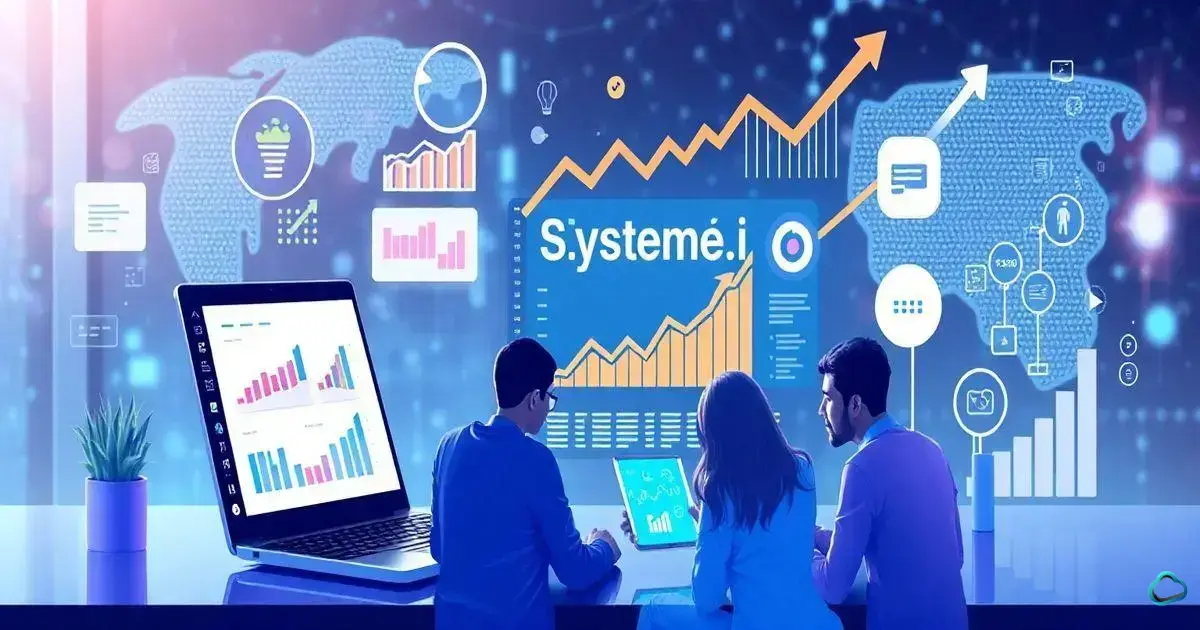Contents
- 1 What are the specific features that the SaaS solution provides?
- 2 How scalable is the software as your business grows?
- 3 What are the pricing options and any hidden fees?
- 4 What security measures are in place to protect your data?
- 5 What level of customer support is offered?
- 6 How easy is it to integrate with existing systems?
- 7 Frequently Asked Questions about SaaS Solutions
- 7.1 What specific features should I look for in a SaaS solution?
- 7.2 How can I determine if a SaaS solution is scalable?
- 7.3 What pricing options are typically available for SaaS solutions?
- 7.4 Are there hidden fees associated with SaaS solutions?
- 7.5 What security measures should I expect from a SaaS provider?
- 7.6 What level of customer support should I expect?
- 7.7 How important is integration with existing systems?
Choosing the right SaaS solution is crucial for business success, and key factors to consider include specific features that align with operational needs, scalability for future growth, transparent pricing options, robust security measures, reliable customer support, and ease of integration with existing systems. Evaluating these aspects will help ensure the selected solution meets both current and future business requirements.
Choosing the right Software as a Service (SaaS) solution is critical for the success of your business. With a plethora of options available, making an informed choice can be daunting. To help streamline your decision-making process, we have compiled a list of the 10 essential questions that you should ask before committing to a SaaS provider. These questions will guide you to assess functionality, security, scalability, and customer support, ensuring that the solution you choose aligns perfectly with your business objectives.
What are the specific features that the SaaS solution provides?
When selecting a SaaS solution, it’s essential to understand the specific features it offers. A thorough evaluation of these features will ensure that the software aligns with your organizational needs and improves efficiency. Here are key aspects to consider when assessing the features of a potential SaaS provider:
User Interface: An intuitive and user-friendly interface that enhances user experience and reduces the learning curve for your team.
Customization Options: The ability to customize features and workflows to match your unique business processes and requirements.
Collaboration Tools: Integrated tools that facilitate communication and collaboration among team members, such as chat, document sharing, and task management.
Mobile Accessibility: Responsive design or dedicated mobile applications that allow access to the software on various devices, enhancing convenience for remote staff.
Analytics and Reporting: Built-in analytics tools that provide insights into data, performance metrics, and user behavior, aiding in informed decision-making.
Security Features: Robust security measures, including encryption, multi-factor authentication, and regular security audits to protect sensitive data.
Integration Capabilities: The capacity to connect seamlessly with other tools and platforms, such as CRMs, ERPs, and payment gateways, ensuring streamlined operations.
Customer Support Features: Access to comprehensive customer support resources, including tutorials, documentation, and live support options for troubleshooting.
A careful assessment of the specific features offered by a SaaS solution is crucial in ensuring it meets your organization’s needs. By looking into these key aspects, you can make a more informed decision and select a solution that enhances productivity and supports your business goals.
How scalable is the software as your business grows?

Scalability is a critical factor to consider when choosing a SaaS solution. As your business expands, it’s essential that the software can adapt to your increasing demands without sacrificing performance or requiring a complete overhaul. Here are key considerations to evaluate the scalability of a SaaS solution:
Resource Availability: Confirm that the SaaS provider can offer additional resources such as higher bandwidth, more storage, or enhanced processing power as your usage grows.
User Capacity: Examine whether the solution allows for adding more users easily and whether there are limits on the number of concurrent users or accounts.
Feature Expansion: Check if the provider offers modular features or add-ons that can be integrated as your business needs evolve, allowing you to customize the solution over time.
Performance Consistency:
Ensure that the software maintains high performance levels under increased load, including response times and uptime guarantees.
Flexibility and Customization: Look for flexibility in pricing and customization that allows for adjustments based on changing business requirements without incurring significant costs.
Migration Support: Assess the support available for migrating data and functionalities as your business scales, ensuring smooth transitions without data loss.
Future-Proofing: Evaluate the SaaS provider’s technology stack and roadmap, ensuring they are committed to continuous improvement and can adapt to future trends.
Assessing the scalability of a SaaS solution is critical to future-proofing your business operations. By understanding how a provider can support your growth and adapt to changing needs, you can make a more informed decision that positions your company for long-term success.
Understanding the pricing structure and potential hidden fees of a SaaS solution is crucial for effective budgeting and long-term financial planning. Transparent pricing models minimize surprises and ensure that you are getting value for your investment. Below are some key considerations to help you navigate this aspect effectively:
Pricing Options:
Subscription Tiers
Many SaaS providers offer multiple subscription tiers with different feature sets, allowing you to choose a plan that aligns with your needs and budget.
Pay-As-You-Go
Some SaaS solutions operate on a pay-as-you-go model, charging only for the features or resources you use, which can be beneficial for businesses with fluctuating needs.
Annual vs Monthly Billing
Evaluate whether discounts are available for annual billing vs. monthly billing, as long-term commitments often yield cost savings.
Freemium Model
Consider if the SaaS provider offers a freemium model that allows you to use basic features for free, with the option to upgrade to a paid plan for advanced functionality.
Custom Pricing
Larger businesses or enterprises may be eligible for custom pricing plans based on their specific requirements; inquire about this possibility if it applies.
Hidden Fees:
Setup Fees
Be aware of any initial setup fees, which can sometimes be charged for account creation or onboarding processes.
Usage Fees
Check if there are additional usage fees based on API calls, storage limits, or user accounts, especially if you expect to scale usage significantly.
Upgrade Fees
Clarify if there are additional costs associated with upgrading to higher service tiers or if certain features come with an extra charge.
Cancellation Fees
Understand the provider’s cancellation policy; some may charge fees if you choose to cancel before the contract term ends.
Support Fees
Verify if advanced support or priority customer service incurs additional charges, especially if your business requires rapid response times.
A clear understanding of the pricing options and potential hidden fees associated with a SaaS solution is essential for effective long-term planning. By thoroughly reviewing these elements, you can avoid unexpected costs and ensure that the solution aligns with your budget and financial expectations.
What security measures are in place to protect your data?

In today’s digital landscape, data security is paramount when selecting a SaaS solution. Your organization’s sensitive information needs to be protected from breaches and unauthorized access. A thorough understanding of the security measures implemented by a SaaS provider is essential. Here are key security aspects to consider:
Data Encryption: Ensure that data is encrypted at rest and in transit using robust encryption protocols (e.g., AES-256) to safeguard sensitive information from interception.
Multi-Factor Authentication (MFA): Check if the provider offers multi-factor authentication to add an extra layer of security, requiring more than just a password for user access.
Regular Security Audits: Inquire if the provider conducts regular security audits and vulnerability assessments to identify and mitigate potential security weaknesses.
Compliance with Standards: Confirm that the SaaS solution complies with industry standards and regulations such as GDPR, HIPAA, or PCI-DSS relevant to your business.
Data Backup and Recovery: Assess the provider’s data backup protocols and recovery strategies to ensure that your data can be restored swiftly in case of loss or corruption.
Access Control and Permissions: Evaluate how access to the data is managed, including role-based access control (RBAC) to restrict data access based on user roles.
Physical Security: Determine what physical security measures are in place at data centers, including surveillance, security personnel, and controlled access to facilities.
Incident Response Plan: Ensure that the SaaS provider has a well-defined incident response plan to address data breaches or security incidents efficiently.
Understanding the security measures in place to protect your data is vital when selecting a SaaS solution. By verifying these aspects, you can ensure that your sensitive information is adequately safeguarded against potential threats, ultimately building trust in your provider.
What level of customer support is offered?
Customer support is a crucial aspect of any SaaS solution, as it ensures that help is available when you encounter issues or have questions. Understanding the level and quality of customer support offered by a SaaS provider can significantly influence your decision. Below are key points to consider when evaluating customer support:
24/7 Availability: Check if the provider offers round-the-clock support to address issues at any time, which is especially important for businesses operating in multiple time zones.
Support Channels: Review the various support channels available, such as email, phone, live chat, and support forums, to ensure that you can reach out through your preferred method.
Response Times: Inquire about average response times for different support channels to understand how quickly you can expect assistance when issues arise.
Knowledge Base and Resources: Evaluate the availability of a comprehensive knowledge base, tutorials, documentation, and FAQs that can help users solve common problems independently.
Onboarding and Training: Check if the provider offers onboarding sessions or training resources to help you and your team maximize the software’s features.
Dedicated Account Manager: For larger organizations, inquire if a dedicated account manager is assigned to provide personalized support and to manage your account effectively.
User Community and Forums: Look for an active user community or forums where you can interact with other users, share knowledge, and get peer support.
Feedback and Improvement: Determine if the provider actively seeks feedback and makes improvements based on user suggestions to enhance the customer experience.
Understanding the level of customer support offered by a SaaS provider is essential for ensuring a smooth experience. By evaluating these key elements, you can ensure that you have the necessary support to resolve issues effectively and make the most of your SaaS solution.
How easy is it to integrate with existing systems?

Integration capabilities are a crucial factor in determining the effectiveness of a SaaS solution within your existing technology ecosystem. A seamless integration can enhance productivity and streamline operations, while difficulties in integration may lead to data silos and operational inefficiencies. Here are some essential considerations when evaluating integration ease:
API Availability: Check if the SaaS provider offers a robust API (Application Programming Interface) that facilitates easy data exchange and interoperability with other software.
Pre-built Integrations: Evaluate the availability of pre-built integrations with popular tools and platforms you currently use, which can simplify the integration process.
Custom Integration Options: Inquire whether the provider supports custom integration solutions if your existing systems require unique configurations.
Integration Documentation: Assess the quality of the integration documentation available, including guides and examples that can help facilitate a smoother integration process.
Ease of Use: Look for user-friendly interfaces or integration wizards that simplify the connection process, making it accessible even for non-technical staff.
Support for Data Migration: Determine whether the provider offers assistance or tools for migrating existing data into the new system, which can be a significant aspect of integration.
Testing and Sandbox Environments: Check if the SaaS provider allows for testing in a sandbox environment, enabling you to experiment with integrations without impacting live systems.
Scalability of Integrations: Assess how well the integrations can scale as your business grows and more systems are added, ensuring that the solution remains effective over time.
The ease of integrating a SaaS solution with your existing systems is fundamental to ensuring operational efficiency and maximizing the value of your investment. By carefully examining these integration factors, you can make a more informed decision and ensure a smoother transition to your new SaaS environment.
Choosing the right SaaS solution for your business is a vital decision that can significantly impact your operations and growth.
By carefully considering key aspects such as specific features, scalability, pricing options, security measures, customer support, and integration ease, you can make an informed decision that aligns with your organizational needs and goals.
Final Thoughts
Taking the time to ask the right questions and thoroughly assess potential providers will not only help you select a solution that meets your immediate requirements but also position your business for future success.
A thoughtful approach to your SaaS selection process will ensure that you are well-equipped to tackle both current challenges and those that may arise as your business continues to evolve.
Frequently Asked Questions about SaaS Solutions
What specific features should I look for in a SaaS solution?
Key features to consider include an intuitive user interface, customization options, collaboration tools, mobile accessibility, analytics and reporting capabilities, robust security features, integration capabilities, and customer support resources.
How can I determine if a SaaS solution is scalable?
To assess scalability, evaluate the provider’s resource availability, user capacity limits, feature expansion options, performance consistency under load, flexibility in pricing, and the support provided for migrating data as you scale.
What pricing options are typically available for SaaS solutions?
SaaS providers usually offer various pricing options, including subscription tiers, pay-as-you-go pricing, annual vs. monthly billing plans, freemium models, and custom pricing for larger enterprises.
Yes, some common hidden fees may include setup fees, usage fees, upgrade fees, cancellation fees, and additional charges for advanced support services. It’s essential to review the pricing structure carefully to avoid surprises.
What security measures should I expect from a SaaS provider?
Look for comprehensive security measures such as data encryption, multi-factor authentication, regular security audits, compliance with industry standards, robust data backup and recovery options, access control, physical security at data centers, and a clear incident response plan.
What level of customer support should I expect?
Evaluate the availability of 24/7 support, multiple support channels (such as email, phone, and live chat), response times, a knowledge base, onboarding resources, dedicated account management, community support, and a commitment to continuous improvement.
How important is integration with existing systems?
Integration is crucial for ensuring seamless operations. Assess the provider’s API availability, pre-built integrations, custom integration options, ease of use, data migration support, and scalability of integrations to ensure compatibility with your existing technology.




